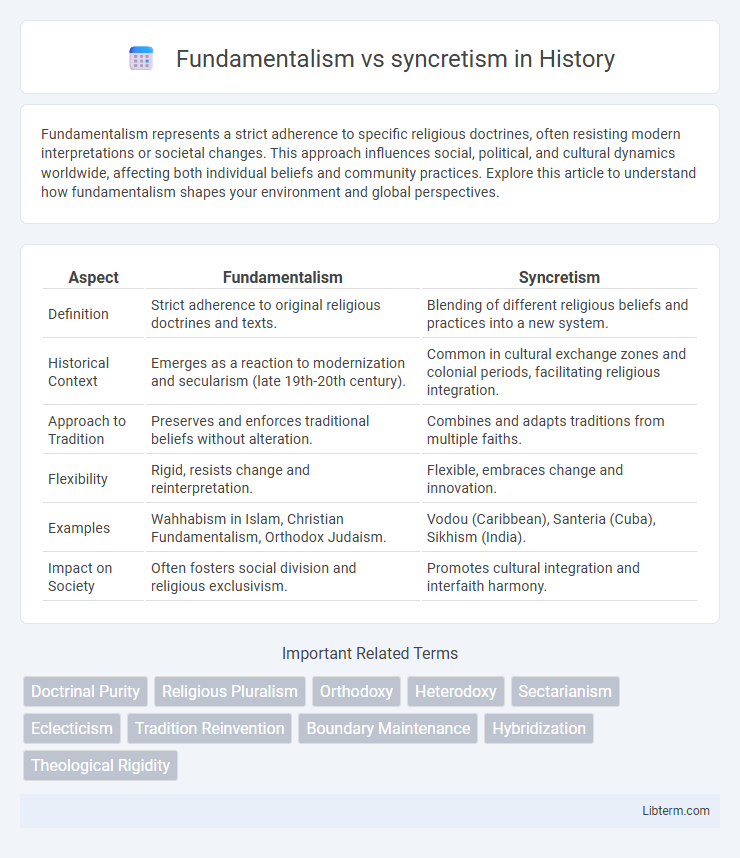Fundamentalism represents a strict adherence to specific religious doctrines, often resisting modern interpretations or societal changes. This approach influences social, political, and cultural dynamics worldwide, affecting both individual beliefs and community practices. Explore this article to understand how fundamentalism shapes your environment and global perspectives.
Table of Comparison
| Aspect | Fundamentalism | Syncretism |
|---|---|---|
| Definition | Strict adherence to original religious doctrines and texts. | Blending of different religious beliefs and practices into a new system. |
| Historical Context | Emerges as a reaction to modernization and secularism (late 19th-20th century). | Common in cultural exchange zones and colonial periods, facilitating religious integration. |
| Approach to Tradition | Preserves and enforces traditional beliefs without alteration. | Combines and adapts traditions from multiple faiths. |
| Flexibility | Rigid, resists change and reinterpretation. | Flexible, embraces change and innovation. |
| Examples | Wahhabism in Islam, Christian Fundamentalism, Orthodox Judaism. | Vodou (Caribbean), Santeria (Cuba), Sikhism (India). |
| Impact on Society | Often fosters social division and religious exclusivism. | Promotes cultural integration and interfaith harmony. |
Understanding Fundamentalism: Core Beliefs and Practices
Fundamentalism centers on strict adherence to specific religious doctrines, emphasizing literal interpretation of sacred texts and resistance to modern reinterpretations. Core beliefs include unwavering commitment to traditional values, moral absolutes, and often a clear distinction between right and wrong based on scripture. Practices commonly involve regular rituals, conservative dress codes, and active efforts to preserve religious identity against perceived secular influences.
Defining Syncretism: Blending Religions and Traditions
Syncretism refers to the process of blending different religious beliefs, practices, and traditions into a cohesive system that creates new, hybrid forms of spirituality. This phenomenon often emerges in multicultural societies where interaction between diverse faiths leads to the integration of rituals, symbols, and doctrines from multiple origins. Unlike fundamentalism, which strictly adheres to original religious texts and practices, syncretism embraces adaptation and synthesis to form inclusive and evolving religious identities.
Historical Roots of Fundamentalism
Fundamentalism emerged in the early 20th century as a reaction against modernist interpretations of religion, particularly within Christianity, emphasizing a literal interpretation of sacred texts. Its historical roots trace back to the publication of "The Fundamentals" between 1910 and 1915, a series of essays defending traditional doctrines against theological liberalism and secularism. This movement sought to preserve religious orthodoxy in the face of scientific advancements and social change, distinguishing itself sharply from syncretism, which blends diverse cultural and religious beliefs.
The Evolution of Syncretism Across Cultures
Syncretism has evolved as a dynamic cultural process where diverse religious and philosophical doctrines merge, reflecting historical interactions and social integration across civilizations. Unlike fundamentalism, which strictly adheres to orthodox beliefs, syncretism encourages adaptation and blending, evident in the fusion of Greek and Buddhist traditions during the Hellenistic period or the incorporation of Indigenous practices within Latin American Christianity. This evolution highlights syncretism's role in fostering cultural hybridity and enhancing cross-cultural understanding in a globalized world.
Key Differences: Fundamentalism vs Syncretism
Fundamentalism emphasizes strict adherence to established doctrines and literal interpretations of sacred texts, often rejecting modern influences and alternative beliefs. Syncretism, by contrast, blends elements from diverse religious or cultural traditions to create a cohesive, hybrid belief system that adapts to changing contexts. The key difference lies in fundamentalism's preservation of purity and exclusivity versus syncretism's promotion of inclusivity and integration.
Societal Impact of Fundamentalist Movements
Fundamentalist movements often lead to increased societal polarization by strictly adhering to traditional beliefs and rejecting modern or diverse perspectives, which can marginalize minority groups and suppress cultural pluralism. These movements may also provoke social unrest and conflict by opposing secular governance, promoting exclusivist identities, and endorsing rigid moral codes that clash with evolving societal values. The impact on education, legal systems, and gender equality is significant, frequently resulting in the reinforcement of hierarchical power structures and limiting progressive social development.
Syncretism’s Role in Cultural Adaptation
Syncretism facilitates cultural adaptation by blending diverse religious and cultural elements, enabling societies to integrate new beliefs without forsaking traditional values. It promotes social cohesion and innovation by creating hybrid practices that address contemporary challenges while respecting historical roots. This dynamic process supports cultural resilience and identity transformation in rapidly changing environments.
Clashes and Dialogues: Interactions Between the Two Approaches
Fundamentalism often clashes with syncretism by rigidly upholding original doctrines while rejecting blended beliefs, leading to conflicts over religious identity and purity. Dialogues between these approaches emerge when fundamentalists engage with syncretic traditions, challenging them to either reaffirm core tenets or adapt through selective incorporation of diverse elements. These interactions shape religious landscapes by prompting debates on authenticity, tolerance, and the evolution of faith in multicultural contexts.
Contemporary Examples of Fundamentalism and Syncretism
Contemporary examples of fundamentalism include Islamist movements like ISIS, which strictly adhere to literal interpretations of religious texts, and Christian Evangelical groups advocating conservative biblical values in political spheres. Syncretism is evident in Afro-Brazilian religions such as Candomble, blending African traditions with Catholicism, and in modern-day Hindu practices incorporating Western spirituality. These phenomena illustrate ongoing tensions between rigid orthodoxies and fluid, integrative belief systems in global religious landscapes.
Future Trends: Toward Rigid Boundaries or Blended Beliefs?
Future trends in fundamentalism versus syncretism indicate a tension between rigid boundaries and blended beliefs, with digital communication amplifying both strict ideological adherence and cross-cultural exchanges. Increasing globalization and online platforms facilitate the merging of diverse religious and cultural elements, promoting syncretism through shared narratives and practices. Concurrently, reactionary movements emphasize doctrinal purity, reinforcing fundamentalist identities in response to perceived threats from hybrid belief systems.
Fundamentalism Infographic

 libterm.com
libterm.com